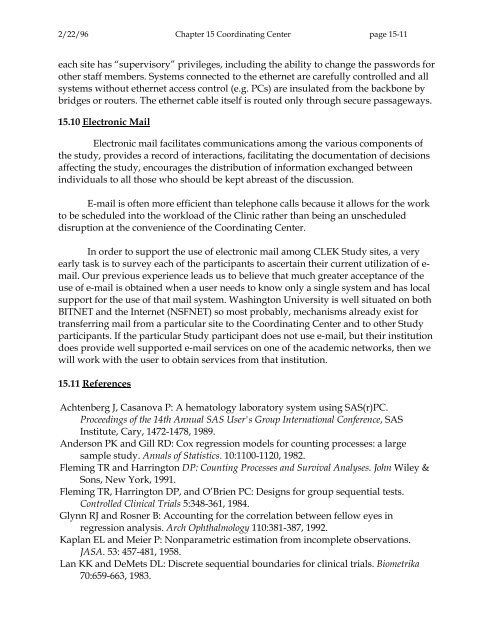OM t of c.iii - Vision Research Coordinating Center - Washington ...
OM t of c.iii - Vision Research Coordinating Center - Washington ...
OM t of c.iii - Vision Research Coordinating Center - Washington ...
You also want an ePaper? Increase the reach of your titles
YUMPU automatically turns print PDFs into web optimized ePapers that Google loves.
2/22/96 Chapter 15 <strong>Coordinating</strong> <strong>Center</strong> page 15-11<br />
each site has “supervisory” privileges, including the ability to change the passwords for<br />
other staff members. Systems connected to the ethernet are carefully controlled and all<br />
systems without ethernet access control (e.g. PCs) are insulated from the backbone by<br />
bridges or routers. The ethernet cable itself is routed only through secure passageways.<br />
15.10 Electronic Mail<br />
Electronic mail facilitates communications among the various components <strong>of</strong><br />
the study, provides a record <strong>of</strong> interactions, facilitating the documentation <strong>of</strong> decisions<br />
affecting the study, encourages the distribution <strong>of</strong> information exchanged between<br />
individuals to all those who should be kept abreast <strong>of</strong> the discussion.<br />
E-mail is <strong>of</strong>ten more efficient than telephone calls because it allows for the work<br />
to be scheduled into the workload <strong>of</strong> the Clinic rather than being an unscheduled<br />
disruption at the convenience <strong>of</strong> the <strong>Coordinating</strong> <strong>Center</strong>.<br />
In order to support the use <strong>of</strong> electronic mail among CLEK Study sites, a very<br />
early task is to survey each <strong>of</strong> the participants to ascertain their current utilization <strong>of</strong> e-<br />
mail. Our previous experience leads us to believe that much greater acceptance <strong>of</strong> the<br />
use <strong>of</strong> e-mail is obtained when a user needs to know only a single system and has local<br />
support for the use <strong>of</strong> that mail system. <strong>Washington</strong> University is well situated on both<br />
BITNET and the Internet (NSFNET) so most probably, mechanisms already exist for<br />
transferring mail from a particular site to the <strong>Coordinating</strong> <strong>Center</strong> and to other Study<br />
participants. If the particular Study participant does not use e-mail, but their institution<br />
does provide well supported e-mail services on one <strong>of</strong> the academic networks, then we<br />
will work with the user to obtain services from that institution.<br />
15.11 References<br />
Achtenberg J, Casanova P: A hematology laboratory system using SAS(r)PC.<br />
Proceedings <strong>of</strong> the 14th Annual SAS User's Group International Conference, SAS<br />
Institute, Cary, 1472-1478, 1989.<br />
Anderson PK and Gill RD: Cox regression models for counting processes: a large<br />
sample study. Annals <strong>of</strong> Statistics. 10:1100-1120, 1982.<br />
Fleming TR and Harrington DP: Counting Processes and Survival Analyses. John Wiley &<br />
Sons, New York, 1991.<br />
Fleming TR, Harrington DP, and O’Brien PC: Designs for group sequential tests.<br />
Controlled Clinical Trials 5:348-361, 1984.<br />
Glynn RJ and Rosner B: Accounting for the correlation between fellow eyes in<br />
regression analysis. Arch Ophthalmology 110:381-387, 1992.<br />
Kaplan EL and Meier P: Nonparametric estimation from incomplete observations.<br />
JASA. 53: 457-481, 1958.<br />
Lan KK and DeMets DL: Discrete sequential boundaries for clinical trials. Biometrika<br />
70:659-663, 1983.
















